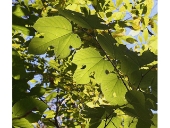I've recently started undergoing a process I am dubbing my "Farm Re-invigoration Project" and am planning a significant scaling-up of plantings this autumn, starting with the orchard. I have already planted 3 more persimmon trees, but in my excitement failed to realize I was geared towards just planting nothing but persimmons (Persimmon season seems to get me going, that and being able to amp-up planting) in the orchard, for trees anyway. I still planned on adding goumi berries and pigeon peas, as well as a selective proliferation of wildflowers already present such as goldenrod, deer's tongue/or vanilla leaf, and a low-growing creeping native crotalaria spp. known as "rabbit bells" in between the rows and around the base of the trees. Probably I was going to let the wild dewberries and blue huckleberries creep their way in, too. So I guess, not quite a monoculture. Still, much as I may love persimmons, it felt wrong that they were the only trees I was set to plant in this area, and that I am limiting them to only around 2-3 varieties, due to preference but also performance. Now, I have quite a few mulberry trees which I had planned to similarly segregate into their own rows so that I could space them farther apart and let them get bigger, as left to their own devices they would quickly overtake the persimmons (I should mention, I am planting only japanese persimmons, of smaller stature). However, now I am thinking I should mix up the party after all. Plant the persimmons with the mulberries and then just keep the mulberries a bit more judiciously pruned. I still want them to have that "tree" form rather than a "bush" though, to completely fill out their 15ft of spacing between persimmons, and because the deer have taken a liking to their leaves. That and I have other spaces to put bushy mulberries, in more of a hedgerow fashion. So now I'm thinking, "better, closer, warmer", still not there yet though. Watching some of "The Permaculture Orchard" videos with Stefan Sobkowiak has me considering, well maybe I should add nitrogen fixing trees. Since I'm already planting goumi in the understory and between rows, I dont want to add another eleagnus for the tree position. I was thinking mimosa, but in my past experience they have a tendency to, well, die. Abruptly and without warning, unless growing on the edges of the woods, not so much a full sun tree down here. I'm toying with the idea of honey locust or black locust but I know they could easily out-grow their 15ft constraints, and I have no experience with their ability to withstand coppicing or just heavy pruning, or any experience with them at all for that matter. I've never seen them in the wild here and I'm not certain I want to deal the thorns, especially not from honeylocust -I know I can get the thornless variety but according to some old posts on here, and some miscellaneous things found on the web it seems like the pods of the thornless variety are better suited to livestock forage than human forage due to some weird allergic reaction people have to it, something along the lines of severe tingling of the tongue and mouth. That search brought me to wax myrtle, which I had no idea until just recently that it fixed any nitrogen at all. Wax myrtle is a locally abundant wild plant in my area, and I already have it popping up all over the place by itself. I've actually dug up a couple plants from inconvenient areas of my yard and relocated them to their permanent homes in one of my hedgerows, and I could easily do the same thing to populate them in the orchard. There's actually a couple in some of the freshly cleared orchard rows that don't have anything planted in them yet that are 3-4ft tall and I just didn't have the heart to get rid of them yet. Well maybe now I wont have to, and worst case scenario I'll dig them up and move them a couple feet to a more ideal position in the row. I am a little concerned about the overall vigor of wax myrtle though, that it could be too vigorous for this style of planting. I was thinking the rows would be something like: Persimmon - wax myrtle- mulberry - persimmon - wax myrtle - mulberry, and then the next row would be the opposite. These fruit trees are themselves probably some of the most vigorous, too, so I'm thinking there's no better trio for my particular area, but I'd love to hear everybody's thoughts, do you think this is a good configuration? Do you know of other plants or trees that might work in such a guild? Have you used wax myrtle this way before? Let me know! :)







